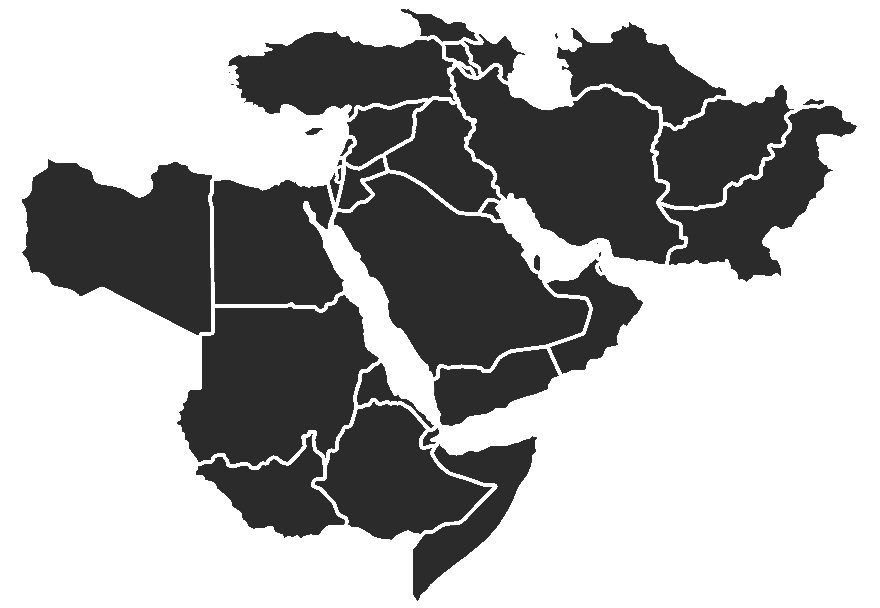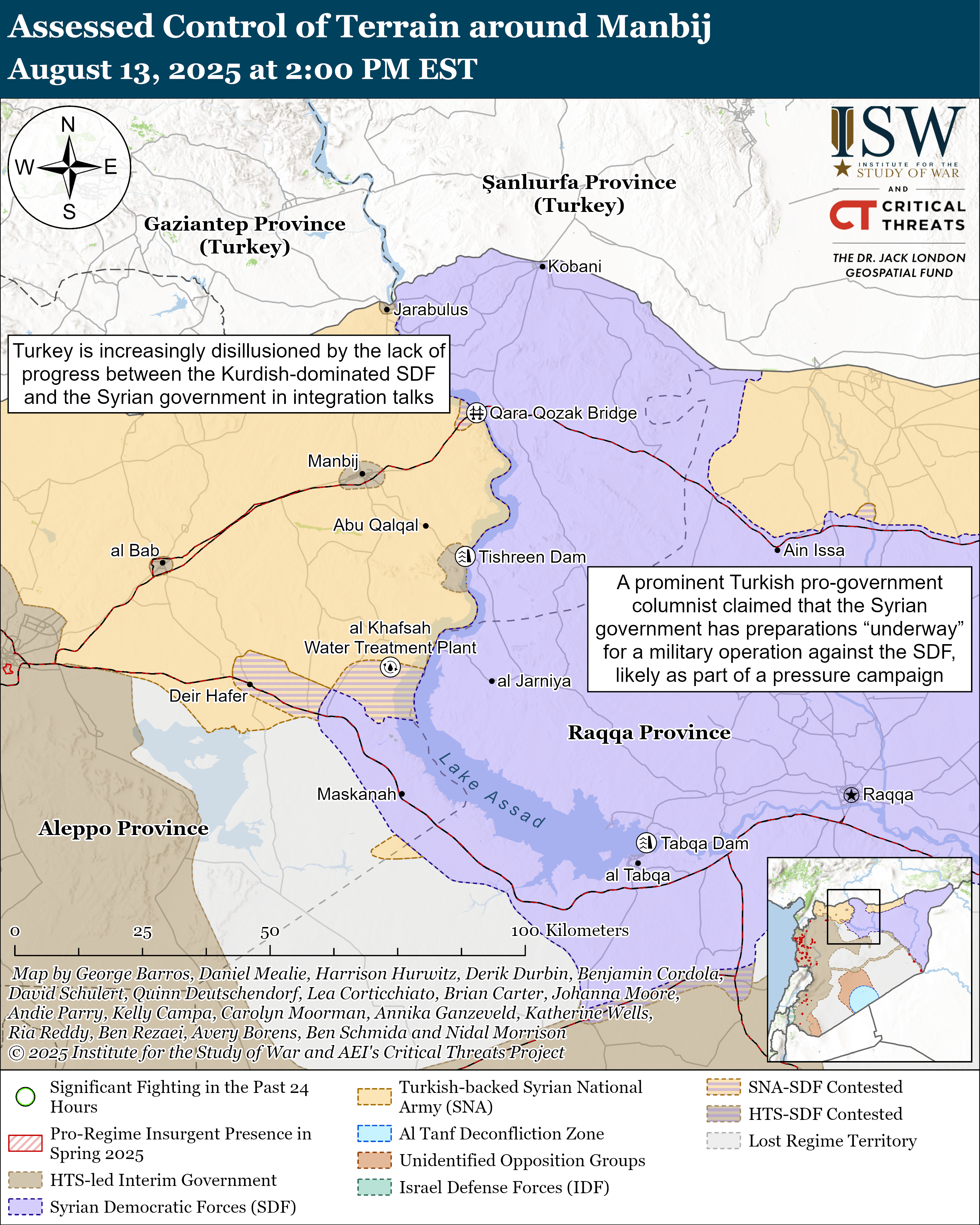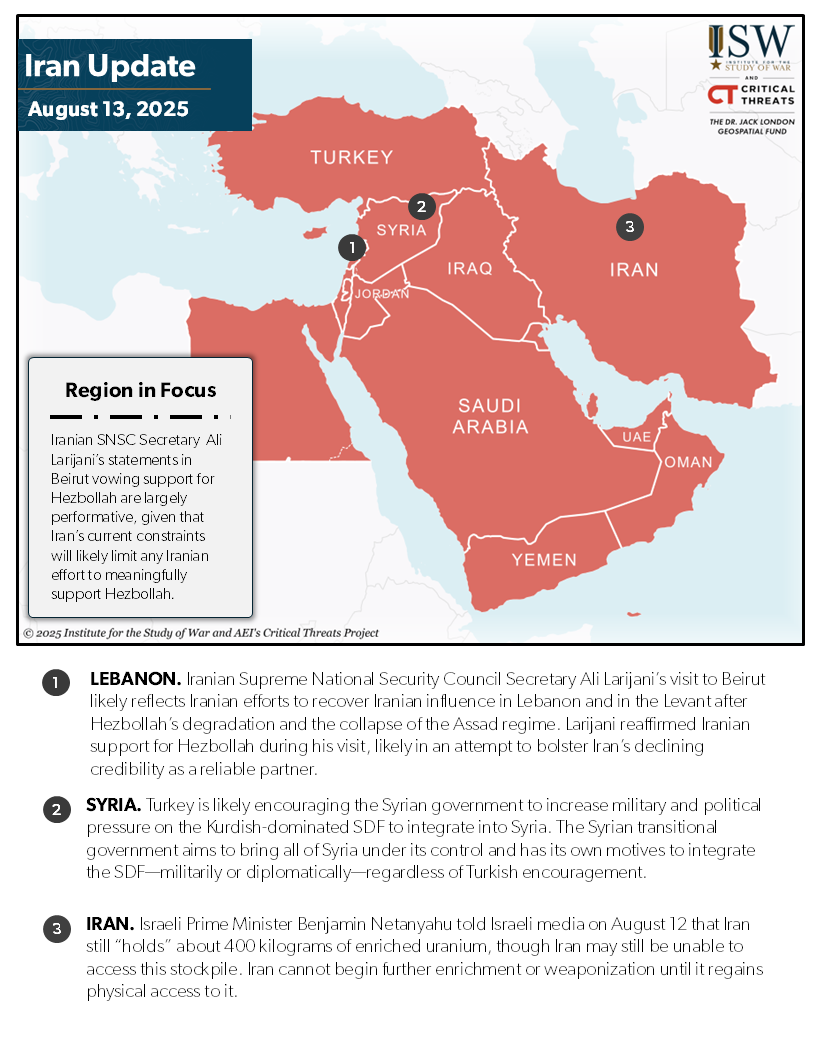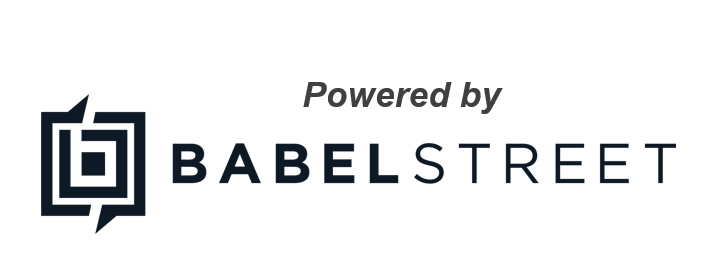{{currentView.title}}
August 13, 2025
Iran Update, August 13, 2025
Information Cutoff: 2:00 PM ET
The Critical Threats Project (CTP) at the American Enterprise Institute and the Institute for the Study of War (ISW) publish the Iran Update, which provides insights into Iranian and Iranian-sponsored activities that undermine regional stability and threaten US forces and interests. CTP-ISW publishes the Iran Update daily.
Click here to see CTP and ISW’s interactive map of assessed control of terrain in Syria, and here to see CTP and ISW’s interactive map of Israeli ground operations. The Syria map is updated daily alongside the static Syria maps in this report. CTP-ISW ended daily maps of Israeli ground operations in February 2025.
Click here to see ISW-CTP's interactive map showing the total strikes in Iran since June 12, as well as an interactive timelapse showing the strikes day-by-day.
Iranian Supreme National Security Council (SNSC) Secretary Ali Larijani’s visit to Beirut likely reflects Iranian efforts to recover Iranian influence in Lebanon and in the Levant after Hezbollah’s degradation and the collapse of the Assad regime. Larijani met with Lebanese President Joseph Aoun, Prime Minister Nawaf Salam, and Parliament Speaker Nabih Berri on August 13.[i] Aoun and Salam are currently leading the state’s efforts to disarm Hezbollah, and Berri is Hezbollah’s highest-ranking ally in the Lebanese government. An Iranian analyst close to the regime stated on August 13 that Larijani’s visit aimed to “prevent a complete shift in Lebanon’s internal power balance to the detriment of Hezbollah.”[ii] Larijani likely seeks to meet with anti-Hezbollah Lebanese politicians as part of a broader strategy to halt the implementation of a Hezbollah disarmament plan. The Lebanese government tasked the Lebanese Armed Forces (LAF) with creating a plan to establish a state monopoly on arms on August 5 and agreed to the objectives of the US proposal to disarm Hezbollah on August 7.[iii] The United States and Israel also decided on August 13 to renew the United Nations Interim Force in Lebanon (UNIFIL)’s contract and expand UNIFIL‘s authority to stage raids, arrest individuals, and erect checkpoints.[iv] UNIFIL has previously rarely taken steps to challenge Hezbollah in southern Lebanon, but expanded activities may allow UNIFIL to challenge Hezbollah in some way.[v]
Larijani also reaffirmed Iranian support for Hezbollah during his visit, likely in an attempt to bolster Iran’s declining credibility as a reliable partner. Larijani reaffirmed Iran’s support for Hezbollah and called on Lebanese civilians to “preserve the resistance” during a press conference following his meeting with Berri.[vi] Hezbollah is also referred to as the Islamic Resistance in Lebanon by pro-Iran actors.[vii] Larijani stated that Iran will stand by Lebanon in the case of ”any Israeli escalation.”[viii] Larijani is likely attempting to reaffirm Iran’s support for Hezbollah after Iran failed to support Hezbollah during the Israeli campaign in Lebanon and after the damage Iran suffered in the Israel-Iran War.[ix] Iran also failed to act quickly enough to defend its Syrian ally, the Bashar al Assad regime, from an HTS-led offensive that led to the regime’s collapse.[x] Iran likely needs to take efforts to bolster its credibility with Hezbollah and regionally. Iranian support for its proxies and partners in the Levant has long served as a form of Iranian deterrence against Israel.
Larijani’s statements vowing support for Hezbollah are largely performative, given that Iran’s current constraints will likely severely limit any Iranian effort to meaningfully support Hezbollah. The fall of the Assad regime in Syria and the Lebanese state’s crackdown on Iranian smuggling through Lebanese airports and border crossings have rendered any Iranian effort to resupply Hezbollah relatively slow and inefficient.[xi] Iran’s inability to smuggle weapons and money to Hezbollah forces has forced Iran to rely on sending Hezbollah cash transfers rather than large shipments of weapons.[xii] Lebanon has been able to interdict some of these cash transfers.[xiii] Iran’s need to rebuild and re-focus its domestic strategy after the Israel-Iran War will likely further constrain available Iranian financial support for Hezbollah.[xiv] Iran may seek to retain its influence in Lebanon, but could struggle to provide real support. Larijani notably made no explicit comments about exact types of support Lebanon or Hezbollah could expect beyond reaffirming Iran's solidarity with Hezbollah and rejecting calls for the group to disarm.[xv]
Turkey is likely encouraging the Syrian government to increase military and political pressure on the Kurdish-dominated Syrian Democratic Forces (SDF) to integrate into Syria. Turkey has become increasingly disillusioned with integration negotiations between the SDF and the Syrian transitional government. Turkey pressured Syria to withdraw from the US- and French-brokered integration negotiations in Paris with the SDF, which undermines US policy objectives in Syria.[xvi] Turkish Foreign Minister Hakan Fidan also likely discussed the SDF and integration efforts with Syrian Foreign Minister Asaad al Shaibani during their meeting on August 13.[xvii] Fidan said that Turkey is observing behavior from the SDF in Syria that ”we find hard to tolerate.“[xviii] Fidan and Shaibani probably did not discuss military planning, but it is nonetheless notable that a pro-government Turkish columnist said on August 13 that the Syrian government is preparing a military operation against the SDF.[xix] The Syrian transitional government aims to bring all of Syria under its control and has its own motives to integrate the SDF—militarily or diplomatically—regardless of Turkish encouragement. Such an operation would, however, likely require Turkish approval due to the degree of Turkish influence in Syria and its government. Another Turkish journalist who has previously written for government outlets claimed that Turkish sources said that US officials told the SDF that the United States may not be able to support the SDF against the Syrian army or Turkey.[xx] Turkish armed forces would reportedly provide indirect support for a ”limited operation” against the SDF by the transitional government.[xxi] Turkey is motivated to fully dismantle the SDF because its sees the continued existence of the SDF as a threat to its regional ambitions and domestic stability.
Turkish influence continues to grow within the Syrian military amid this pressure effort. Turkish and Syrian defense officials signed a military training and “consultation” agreement in Ankara on August 13 after Syria requested Turkish military support to strengthen its counterterrorism capabilities on July 23.[xxii] The Turkish Defense Ministry will provide training programs and technical support to strengthen the Syrian army and ”reform the security apparatus comprehensively.”[xxiii] This agreement could give Turkey additional leverage over the Syrian government, amid additional Turkish avenues of influence. Turkey has continued to provide salaries for elements of the Syrian army, such as the Syrian National Army (SNA).[xxiv] Turkey also holds economic sway over the Syrian government through recent energy and trade deals.[xxv]
Additional Turkish defense cooperation with the Syrian government may discourage the SDF from integrating into the Syrian army because of the relations between Turkey and the Kurds. Kurds in northeastern Syria have come under threat from Turkish-backed forces that are now affiliated with the government throughout the civil war. Some Turkish-backed militias in the SNA are made up of Turkish ethno-nationalists who have committed atrocities against Kurds in northern Syria.[xxvi] The Kurdish-dominated SDF may feel reticent to enter a command structure trained by these former adversaries, particularly if the SDF is not allowed to maintain a Kurdish force to defend Kurds in northeastern Syria. Kurdish communities have repeatedly called for autonomy and voiced their opposition to centralized rule because they view the transitional government as majoritarian and are skeptical of the government’s ability and willingness to protect their communities.[xxvii] The Syrian transitional government’s repeated failure to protect minority communities has reinforced the perception among minority communities that integration under the current government framework is unsafe. This challenge exemplifies the barriers that the transitional government faces in reaching a comprehensive integration agreement through diplomacy.
Israeli Prime Minister Benjamin Netanyahu told Israeli media on August 12 that Iran still “holds” about 400 kilograms of enriched uranium, though Iran may still be unable to access this stockpile.[xxviii] The size of the stockpile is consistent with the International Atomic Energy Agency (IAEA)’s estimate in June 2025 that Iran retained about 408.6 kilograms of 60 percent enriched uranium. The IAEA reported in May that Iran possessed a total enriched uranium stockpile of 9,247.6 kilograms, though this estimate includes uranium enriched to lower levels.[xxix] Netanyahu stated that Israel ”knew in advance” the strikes would not destroy the uranium, which is logical because uranium is an element and therefore cannot be destroyed, only scattered.[xxx] Netanyahu also argued that the stockpile alone is “insufficient to produce a nuclear weapon” without other key elements of Iran’s nuclear program.[xxxi] Netanyahu is likely referring to assets damaged by Israel during the 12-day war, including research and development facilities, explosives manufacturing sites, and knowledge from key nuclear scientists.[xxxii] Netanyahu said the strikes eliminated two “cancerous” threats to Israel’s existence: Iran’s nuclear weapons program and its planned production of 20,000 ballistic missiles.[xxxiii]
It is unclear whether Iran can access its 60 percent enriched uranium because some of the stockpile may be buried under rubble at Fordow or Esfahan.[xxxiv] US and Israeli airstrikes on Fordow and other enrichment facilities may have buried enriched uranium underground, which would limit access to the material.[xxxv] Iran cannot begin further enrichment or weaponization until it regains physical access to it. Western media reports after the initial strikes suggested that Iran may have transferred part of its enriched uranium from nuclear facilities to other sites before the Israeli and US strikes.[xxxvi] Senior Israeli officials have repeatedly warned that Israel would “almost certainly” detect any Iranian attempts to recover the material and conduct renewed strikes to prevent Iran from accessing the material.[xxxvii] Netanyahu stated that Israel continues to monitor Iran’s nuclear weapons program in coordination with the United States and will act with or without US approval.[xxxviii] Iranian President Masoud Pezeshkian acknowledged on August 10 that Israeli strikes had damaged nuclear capabilities and warned that rebuilding them could prompt further attacks.[xxxix]
Key Takeaways
- Iranian Regional Influence: Iranian Supreme National Security Council Secretary Ali Larijani’s visit to Beirut likely reflects Iranian efforts to recover Iranian influence in Lebanon and in the Levant after Hezbollah’s degradation and the collapse of the Assad regime. Larijani reaffirmed Iranian support for Hezbollah during his visit, likely in an attempt to bolster Iran’s declining credibility as a reliable partner. Larijani’s statements vowing support for Hezbollah are largely performative, given that Iran’s current constraints will likely limit any Iranian effort to meaningfully support Hezbollah.
- Turkey and Syria: Turkey is likely encouraging the Syrian government to increase military and political pressure on the Kurdish-dominated SDF to integrate into Syria. The Syrian transitional government aims to bring all of Syria under its control and has its own motives to integrate the SDF—militarily or diplomatically—regardless of Turkish encouragement.
- Iranian Nuclear Program: Israeli Prime Minister Benjamin Netanyahu told Israeli media on August 12 that Iran still “holds” about 400 kilograms of enriched uranium, though Iran may still be unable to access this stockpile. Iran cannot begin further enrichment or weaponization until it regains physical access to it.
Iran
Iran failed to respond to an offer from the E3–United Kingdom, France, and Germany–to extend the August 31 deadline for Iran to return to nuclear negotiations with the E3 before the E3 trigger snapback mechanism.[xl] This ”limited extension“ would grant Iran more time to commit to a new nuclear agreement that would address the E3’s concerns before the snapback mechanism expires in October 2025.[xli] The E3 has expressed that Iran needs to cooperate with the International Atomic Energy Agency (IAEA) and remove their 60 percent enriched uranium stockpile to avert the imposition of snapback sanctions.[xlii] Iran is unlikely to reverse its June 26 decision to officially ban cooperation with the IAEA. This continued ban leaves Iran-E3 negotiations at a standstill.[xliii] Iran notably did not allow an IAEA delegation to inspect Iranian nuclear facilities during its visit to Tehran on August 12.[xliv] Iranian Foreign Affairs Minister Abbas Araghchi separately told reporters on August 11 that Iran has not set a date for further talks with the E3.[xlv] The Joint Comprehensive Plan of Action (JCPOA) snapback mechanism–which re-imposes UN sanctions–requires up to 30 days to complete, which requires the E3 to start the process by September 2025 before the snapback mechanism expires in October.[xlvi]
Iranian officials met with Armenian officials on August 13 to discuss their opposition to the proposed Zangezur Corridor.[xlvii] Iranian Supreme Leader International Affairs Adviser Ali Akbar Velayati met with Armenian Deputy Foreign Minister Vahan Kostanyan on August 13 to discuss the recent US-brokered peace deal between Armenia and Azerbaijan.[xlviii] The deal grants the United States exclusive development rights to the Zangezur Corridor, which is a Turkish- and Azerbaijani-proposed transit route that would connect Azerbaijan to its exclave, the Nakhchivan Autonomous Region. Iran opposes the proposed corridor because it would sever Iranian land access to Russia and Europe via Armenia.[xlix] Velayati warned against foreign intervention in the region in the meeting and stated that any threats to Iran's national security on its borders would prompt an Iranian response.[l] Kostanyan also met with Iranian Foreign Affairs Minister Abbas Araghchi.[li] Araghchi separately met with the Russian Foreign Ministry‘s Special Representative for the Caucasus, Igor Khayev, to emphasize the importance of Russo-Iranian cooperation over the corridor.[lii] Iranian officials have expressed concern in recent years that Russia’s preoccupation with its invasion of Ukraine has enabled Turkey, Israel, and the United States to increase their influence in the southern Caucasus.[liii]
Iraq
US State Department Spokesperson Tammy Bruce stated on August 12 that the United States opposes any Iraqi legislation that would turn Iraq into an “Iranian satellite state,” referencing the Popular Mobilization Authority Law and a recent Iran-Iraq Memorandum of Understanding (MoU) regarding border security.[liv] The Popular Mobilization Authority Law, on which the Iraqi Parliament is yet to vote, is likely to increase Iran’s influence in the Iraqi political and security spheres by formalizing the Iranian-backed Popular Mobilization Authority (PMF)’s structures and responsibilities.[lv] Iranian SNSC Secretary Ali Larijani and Iraqi National Security Advisor Qassim al Araji signed an MoU on August 11 to ”develop” the 2023 Iran-Iraq security agreement that requires Iraqi authorities to disarm and relocate members of Kurdish opposition groups from the Iran-Iraq border.[lvi] An unspecified senior security source told Iraqi media on August 13 that the MoU includes mechanisms for joint patrols and intelligence exchanges to address dual threats from the Kurdistan Workers Party (PKK) and Iranian opposition groups based in northern Iraq.[lvii] The signing of this MoU is probably an extension of Iran’s focus on internal security because Iran views Iraqi Kurdistan as a rear area from which anti-regime Kurdish groups can operate in Iran, which threatens the Iranian regime's stability.[lviii] The Iranian Embassy in Baghdad and the Iraqi Embassy in Washington, DC, both condemned Bruce’s comments.[lix]
Syria
See topline section.
Arabian Peninsula
The Houthis launched six drones targeting "vital sites" in Haifa, the Negev Desert, Eilat, and Beer Sheva in Israel on August 12.[lx] The IDF Air Force intercepted a Houthi drone outside of Israeli territory on August 12.[lxi] The Houthis have launched hundreds of drones and ballistic missiles targeting Israel since the Houthis began their campaign to enforce an economic “blockade” on Israel in October 2023.[lxii]
Palestinian Territories and Lebanon
See topline section.
[i] https://x.com/alilarijani_ir/status/1955560700656435226 ; https://x.com/alilarijani_ir/status/1955656249472962993 ; https://x.com/alilarijani_ir/status/1955569715168043124
[ii] https://x.com/Mostafa_Najafii/status/1955617583249363184
[iii] https://understandingwar.org/backgrounder/iran-update-august-6-2025 ; https://understandingwar.org/backgrounder/iran-update-august-7-2025 ; https://www.reuters.com/world/middle-east/us-plan-sees-hezbollah-disarmed-by-year-end-israeli-withdrawal-2025-08-07/
[iv] https://www.naharnet dot com/stories/en/314683-report-israel-us-agree-to-extending-unifil-s-mandate-for-one-last-time
[v] https://x.com/EtatMajorFR/status/1953394699680501817 ; https://www.understandingwar.org/backgrounder/iran-update-october-21-2024
[vi] https://apnews.com/article/lebanon-iran-hezbollah-larijani-aoun-disarming-israel-85ed792f3c57cc3dcee91b147ecdbeef ; https://www.reuters.com/world/middle-east/no-armed-groups-allowed-lebanon-president-tells-hezbollahs-ally-iran-2025-08-13/
[vii] https://www.reuters.com/world/middle-east/no-armed-groups-allowed-lebanon-president-tells-hezbollahs-ally-iran-2025-08-13/
[viii] https://apnews.com/article/lebanon-iran-hezbollah-larijani-aoun-disarming-israel-85ed792f3c57cc3dcee91b147ecdbeef
[ix] https://www.understandingwar.org/backgrounder/israels-victory-lebanon
[x] https://www.understandingwar.org/backgrounder/reshaping-iran%E2%80%99s-axis-resistance
[xi] https://www.understandingwar.org/backgrounder/iran-update-may-25-2023 ; https://carnegieendowment.org/research/2020/03/the-transformation-of-the-iraqi-syrian-border-from-a-national-to-a-regional-frontier?lang=en¢er=middle-east ; https://newlinesmag.com/spotlight/life-returns-to-al-bukamal-after-iranian-militias-flee/ ; https://understandingwar.org/backgrounder/iran-update-august-7-2025
[xii] https://understandingwar.org/backgrounder/iran-update-february-28-2025
[xiii] https://www.fdd.org/analysis/op_eds/2025/03/02/lebanon-seizes-funds-bound-for-hezbollah-at-beirut-airport/
[xiv] https://www.brandeis.edu/stories/2025/june/inside-iran.html
[xv] https://www.nytimes.com/2025/08/13/world/europe/iran-lebanon-hezbollah-disarm.html ; https://www.ynetnews dot com/article/rycnszq00xg
[xvi] https://understandingwar.org/backgrounder/iran-update-august-12-2025
[xvii] https://www.reuters.com/world/middle-east/syrian-kurdish-ypg-should-stop-delaying-syria-integration-turkey-says-2025-08-13/
[xviii] https://www.reuters.com/world/middle-east/syrian-kurdish-ypg-should-stop-delaying-syria-integration-turkey-says-2025-08-13/
[xix] https://www.hurriyet dot com.tr/yazarlar/abdulkadir-selvi/suriyede-sdgye-askeri-operasyon-hazirligi-42912302
[xx] https://www.middleeasteye dot net/news/turkey-warns-syrian-kurds-dont-become-israeli-pawns-0
[xxi] https://www.middleeasteye dot net/news/turkey-warns-syrian-kurds-dont-become-israeli-pawns-0
[xxii] https://t.me/Sy_Defense/869 ; https://t.me/syrianmofaex1/1239 ; https://t.me/syrianmofaex1/1233 ; https://www.aa.com dot tr/en/politics/syrian-government-officially-requests-turkiye-to-help-strengthen-defense-combat-terrorism/3639472
[xxiii] https://sana dot sy/en/?p=368517
[xxiv] https://www.syriarevisited.com/p/the-new-syrian-army-structure-and
[xxv] https://www dot dailysabah.com/business/economy/turkish-firms-move-to-help-restore-syria-infrastructure-advance-trade
[xxvi] https://www.hrw.org/news/2025/05/14/syria-turkiye-backed-armed-groups-detain-extort-civilians ; https://www.newarab.com/analysis/why-fighting-raging-north-syria-between-sna-and-sdf ; https://www.cfr.org/global-conflict-tracker/conflict/conflict-syria
[xxvii] https://syrianobserver.com/syrian-actors/led-by-rami-makhlouf-new-alawite-party-seeks-autonomous-rule-in-syrias-coastal-region.html ; https://www.washingtoninstitute.org/policy-analysis/facilitating-new-sdf-agreement-key-stabilizing-syria
[xxviii] https://www.i24news dot tv/en/news/israel/defense/artc-pm-netanyahu-we-would-have-struck-iran-even-without-the-us ; https://www.youtube.com/watch?v=u8xhaxo2JJY&t=83s
[xxix] https://apnews.com/article/iran-nuclear-iaea-uranium-7f6c9962c1e4199e951559096bcf5cc0?taid=683ae0271dc7320001739354&utm_campaign=TrueAnthem&utm_medium=AP&utm_source=Twitter
[xxx] https://www.i24news dot tv/en/news/israel/defense/artc-pm-netanyahu-we-would-have-struck-iran-even-without-the-us ; https://www.youtube.com/watch?v=u8xhaxo2JJY&t=83s
[xxxi] https://www.i24news dot tv/en/news/israel/defense/artc-pm-netanyahu-we-would-have-struck-iran-even-without-the-us ; https://www.youtube.com/watch?v=u8xhaxo2JJY&t=83s
[xxxii] https://understandingwar.org/backgrounder/iran-update-special-report-june-14-2025-evening-edition ;
https://www.understandingwar.org/backgrounder/iran-update-june-27-2025
[xxxiii] https://www.i24news dot tv/en/news/israel/defense/artc-pm-netanyahu-we-would-have-struck-iran-even-without-the-us ; https://www.youtube.com/watch?v=u8xhaxo2JJY&t=83s
[xxxiv] https://www.understandingwar.org/backgrounder/iran-update-july-12-2025 ;
https://www.understandingwar.org/backgrounder/iran-update-july-1-2025 ;
https://understandingwar.org/backgrounder/iran-update-june-29-2025
[xxxv] https://understandingwar.org/backgrounder/iran-update-june-27-2025
[xxxvi] https://www.nytimes.com/2025/06/26/us/politics/iran-nuclear-program-uranium.html
[xxxvii] https://www.nytimes.com/2025/07/10/us/politics/iran-attacks-damage.html?smid=nytcore-ios-share&referringSource=articleShare ;
[xxxviii] https://www.i24news dot tv/en/news/israel/defense/artc-pm-netanyahu-we-would-have-struck-iran-even-without-the-us ; https://www.youtube.com/watch?v=u8xhaxo2JJY&t=83s
[xxxix] https://www.entekhab dot ir/fa/news/879409
[xl] https://x.com/jnbarrot/status/1955576587736240273
[xli] https://www.ft.com/content/df85f883-e526-45ff-b8d1-789725892574 ; https://www.axios.com/2025/07/15/iran-snapback-sanctions-nuclear-deal
[xlii] https://www.ft.com/content/df85f883-e526-45ff-b8d1-789725892574 ; https://www.axios.com/2025/07/15/iran-snapback-sanctions-nuclear-deal
[xliii] https://x.com/SaeedAzimi1772/status/1938889259840110807
[xliv] https://x.com/IranNuances/status/1954960267814547821 ;
https://www.lemonde.fr/en/international/article/2025/08/12/iran-s-nuclear-progam-un-nuclear-watchdog-leaders-return-to-tehran-after-war-with-israel_6744293_4.html
[xlv] https://www.tasnimnews dot com/fa/news/1404/05/19/3373467; https://x.com/IranNuances/status/1954578246319722778
[xlvi] https://www.sipri.org/sites/default/files/2016-03/UNSC-Res-2231_0.pdf; https://www.axios.com/2025/07/15/iran-snapback-sanctions-nuclear-deal ; https://www.iranwatch.org/sites/default/files/res2231e.pdf
[xlvii] https://www.isna dot ir/news/1404052213786 ; https://defapress dot ir/fa/news/769981
[xlviii] https://www.isna dot ir/news/1404052213786
[xlix] https://www.understandingwar.org/backgrounder/iran-update-august-12-2025 ; https://www.jpost dot com/middle-east/iran-news/article-863925 ; https://www.reuters.com/world/azerbaijan-armenia-publish-text-us-brokered-peace-deal-2025-08-11/
[l] https://www.isna dot ir/news/1404052213786
[li] https://www.khabaronline dot ir/news/2102136/
[lii] https://defapress dot ir/fa/news/769981 ; https://www.khabaronline dot ir/news/2102138/
[liii] https://www.understandingwar.org/backgrounder/iran-update-july-14-2023
[liv] https://www.state.gov/briefings/department-press-briefing-august-12-2025/
[lv] https://www.understandingwar.org/backgrounder/iran-update-august-6-2025 ; https://www.understandingwar.org/backgrounder/iran-update-august-11-2025
[lvi] https://ina dot iq/ar/political/240700-.html ; https://www.reuters.com/world/middle-east/iraq-iran-sign-deal-tighten-border-security-2023-03-19/
[lvii] https://www.shafaq dot com/ar/%D8%A3%D9%85%D9%80%D9%86/%D8%B1%D9%81%D8%B6%D8%AA%D9%87%D8%A7-%D9%88%D8%A7%D8%B4%D9%86%D8%B7%D9%86-%D8%AA%D9%81%D8%A7%D8%B5%D9%8A%D9%84-%D9%85%D8%B0%D9%83%D8%B1%D8%A9-%D8%A7%D9%84%D8%AA%D9%81%D8%A7%D9%87%D9%85-%D8%A7%D9%84-%D9%85%D9%86%D9%8A-%D8%A8%D9%8A%D9%86-%D8%A8%D8%BA%D8%AF%D8%A7%D8%AF-%D9%88%D8%B7%D9%87%D8%B1%D8%A7%D9%86
[lviii] https://www.understandingwar.org/backgrounder/iran-update-august-11-2025
[lix] https://almadapaper dot net/410783/ ; https://www.rudawarabia dot net/arabic/middleeast/iraq/130820251
[lx] https://t.me/army21ye/3288
[lxi] https://x.com/idfonline/status/1955247322968785175
[lxii] https://www.securitycouncilreport.org/whatsinblue/2024/12/briefing-on-developments-related-to-houthi-attacks-on-israel.php ; https://www.timesofisrael dot com/liveblog_entry/idf-says-houthis-have-launched-40-missiles-320-drones-at-israel-since-start-of-war/



